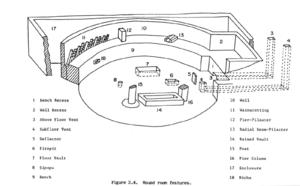Kiva facts for kids
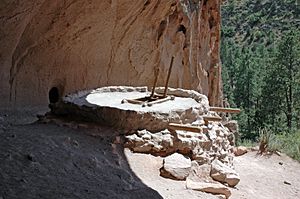
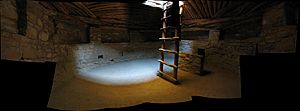
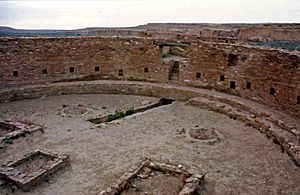
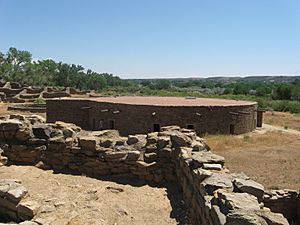
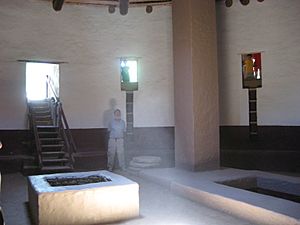
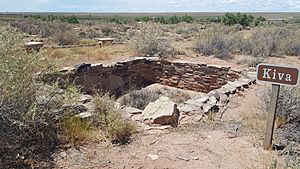
A kiva is a special room used by the Puebloans people. They use it for important traditions and community meetings. Many of these events are linked to their kachina belief system.
For the modern Hopi and other Pueblo groups, a "kiva" is a large, round room. It is usually built underground and used for spiritual ceremonies.
Similar underground rooms are found in ancient ruins across the American Southwest. These were used by old groups like the ancestral Puebloans, the Mogollon, and the Hohokam. The rooms used by the ancient Pueblos were often round. They developed from simpler pit-houses, which were homes dug partly into the ground. These rooms likely served as homes, social gathering spots, and places for ceremonies.
How Kivas Changed Over Time
Around the late 700s, people in the Mesa Verde area began building square pit structures. Archaeologists call these "protokivas." They were usually about 3 or 4 feet deep and 12 to 20 feet wide.
By the mid-900s and early 1000s, these structures changed. They became smaller, round rooms called kivas. These kivas were typically 12 to 15 feet across. Mesa Verde-style kivas had a special feature called a sipapu. This was a small hole in the north side of the room. It is believed to represent where the Ancestral Puebloans thought their people first came from.
When archaeologists find an old room and call it a kiva, they guess what it was used for. They compare it to how kivas are used today. The kachina belief system started around A.D. 1250. But kiva-like buildings existed much earlier. This suggests that the rooms' original uses might have changed over time to fit new religious practices.
As cultures changed, especially between 1150 and 1300, kivas remained very important. Some kivas were even built above ground. Kiva designs became more detailed. For example, kivas found in Mesa Verde National Park were often shaped like a keyhole. In most large communities, there was usually one kiva for every five or six rooms.
Archaeologists have found many kivas that were burned down. This suggests that there might have been conflicts or wars among people in the Southwest during this time.
The huge Great Kiva at Aztec Ruins National Monument has fifteen rooms around its main chamber.
... Their purpose is unclear. ... Each had an outside doorway to the plaza. ... Four huge pillars of stone and wood held up the ceiling beams. These beams supported a roof that weighed about 95 tons. Each pillar rested on four shaped stone disks. Each disk weighed about 355 pounds. These disks were made of limestone, which came from mountains at least 40 miles away.
After 1325 or 1350, the number of rooms per kiva changed. Except in the Hopi and Pueblo areas, there were 60 to 90 rooms for each kiva. This might mean that there were changes in their religion or how their society was organized. It could have affected the number of family groups among the Pueblo people.
Great Kivas
Great kivas are different from regular kivas. Archaeologists sometimes call regular kivas "Chaco-style kivas." Even though Chaco Canyon also has great kivas, they are not the same.
Here are some key differences:
- Great kivas are always much larger and deeper than Chaco-style kivas.
- The walls of great kivas always rise above the ground around them. Chaco-style kiva walls are usually level with the ground.
- Chaco-style kivas are often built into the main parts of large houses. Great kivas are always separate buildings.
- Great kivas almost always have a bench that goes all the way around the inside. This feature is not found in Chaco-style kivas.
- Great kivas also tend to have floor vaults. These might have been used as foot drums for ceremonial dancers. Chaco-style kivas do not have these.
Great kivas are thought to be the first public buildings built in the Mesa Verde region.
See also
 In Spanish: Kiva para niños
In Spanish: Kiva para niños


